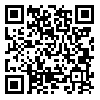Volume 10, Issue 4 (Occupational Medicine Quarterly Journal 2019)
tkj 2019, 10(4): 41-52 |
Back to browse issues page
Department of Occupational Health Engineering, School of Public Health and Safety, Shahid Beheshti University of Medical Sciences, Tehran, Iran. , sahel.khakkar@yahoo.com
Abstract: (2768 Views)
Introduction: The importance of assessing and identifying ergonomic risk factors in the workplace among office workers has increased with the increase in occupational tasks of computer and increasing the risk of physical and mental disorders among its users. One of these factors is the usability of computer hardware and software. The purpose of this study was to evaluate the applicability of office automation software and to measure the fatigue and burnout of employees in an office and determine their correlation.
Methods: In this study, in one of the health centers of Tehran city, staff fatigue and burnout and their use of office automation software by using Multidimensional Job Fatigue Inventory (MFI-20), Maslach Burnout Inventory (MBI) The standard questionnaire was used to evaluate the usability of the software. Data were analyzed by SPSS 23 software.
Results: The findings of this study showed that automation software is very useful for most users. According to the findings of this study, there was a significant negative correlation between software usability and emotional exhaustion dimensions and reduction of personal inadequacy, general fatigue, physical fatigue with correlation coefficients (-0.228, -0.511, -0.372 and -0.287). There was. The greater the usability of the software, the lower the level of employee fatigue and fatigue.
Conclusion: The applicability of job software is effective in fatigue and fatigue of employees. So the usable design of such web-based software should be considered by office systems and software developers and software developers.
Methods: In this study, in one of the health centers of Tehran city, staff fatigue and burnout and their use of office automation software by using Multidimensional Job Fatigue Inventory (MFI-20), Maslach Burnout Inventory (MBI) The standard questionnaire was used to evaluate the usability of the software. Data were analyzed by SPSS 23 software.
Results: The findings of this study showed that automation software is very useful for most users. According to the findings of this study, there was a significant negative correlation between software usability and emotional exhaustion dimensions and reduction of personal inadequacy, general fatigue, physical fatigue with correlation coefficients (-0.228, -0.511, -0.372 and -0.287). There was. The greater the usability of the software, the lower the level of employee fatigue and fatigue.
Conclusion: The applicability of job software is effective in fatigue and fatigue of employees. So the usable design of such web-based software should be considered by office systems and software developers and software developers.
Type of Study: Research |
Subject:
Ergonomics
Received: 2018/08/7 | Accepted: 2019/11/4 | Published: 2019/11/4
Received: 2018/08/7 | Accepted: 2019/11/4 | Published: 2019/11/4
| Rights and permissions | |
 |
This work is licensed under a Creative Commons Attribution-NonCommercial 4.0 International License. |




